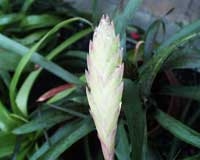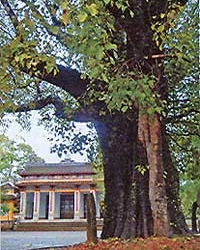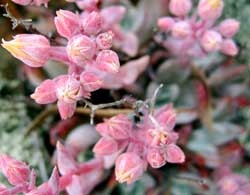The first biomass corn stalks in Vietnam are so tall that many people cannot reach the ears, with the tops of the corn plants nearly touching the streetlights…
Dr. Dang Ngoc Ha – Deputy Director of the Institute of Corn Research (Vietnam Agricultural Science Institute) shares that he has been devoted to corn for over 30 years since his mother gave birth in a corn field. As early as 15 to 20 years ago, when hybrid corn varieties from the Institute were at their peak, yielding profits of hundreds of millions of VND per truckload, he was already focused on researching biomass corn.
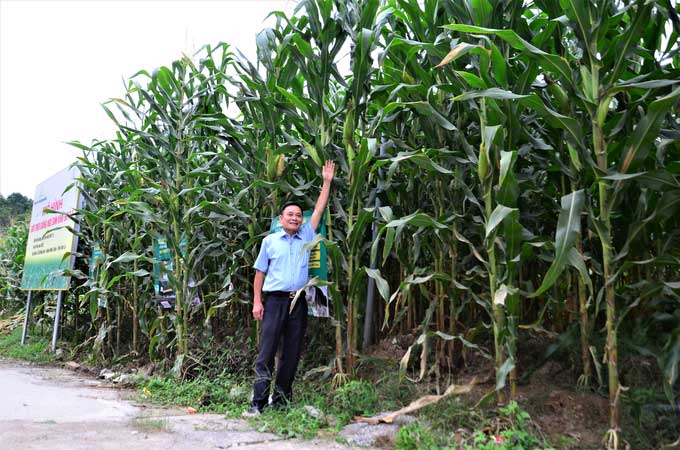
Dr. Dang Ngoc Ha reaching for the ear of corn from the DH17-5 variety. (Photo: Duong Dinh Tuong).
In recent years, a significant transformation has been witnessed in the agricultural structure, with the livestock sector rapidly increasing. The strength of mountainous provinces lies in large livestock farming, necessitating high-quality feed sources such as biomass corn. However, Vietnam lacks specialized corn varieties for biomass production, relying instead on seed corn varieties used for biomass production in a “two-in-one” approach.
Passionate about the new direction of biomass corn, Dr. Ha has tirelessly created lines, tested hybrid combinations, and evaluated them. Among hundreds of hybrids, he identified the most suitable one, DH17-5 (named after him, Dang Ha, and created in 2017). In the same year, Dr. Ha submitted the variety to the National Center for Seed Testing and Crop Product Evaluation. After undergoing basic VCU testing and DUS distinctiveness testing, in 2019, the DH17-5 corn variety was temporarily recognized.
The Covid-19 pandemic halted everything. Dr. Ha was so anxious that he persistently “swabbed his nose” multiple times each month to pass through Covid-19 checkpoints, continuing to take the seeds to various places for trials and perfecting both cultivation and seed production processes.
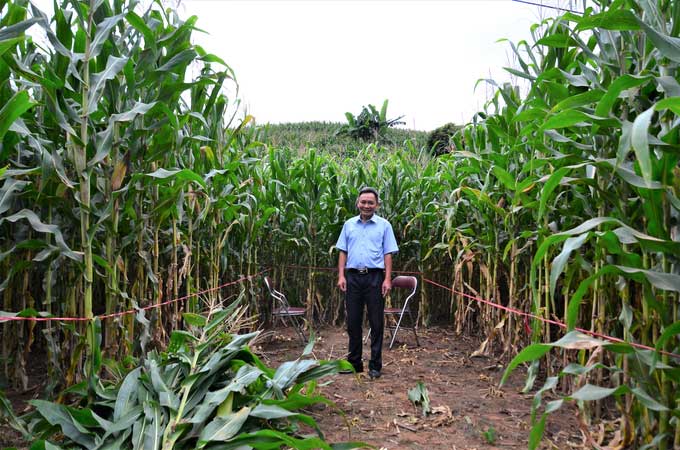
Harvesting 10m2 of DH17-5 biomass corn to weigh and calculate yield. (Photo: Duong Dinh Tuong).
Due to limited funding from the state research project and constrained financial procedures, to bring his “brainchild” to fruition quickly, Dr. Ha used his own money to produce seeds and distribute them. However, when producing 2 hectares of seeds in Chieng Sung (Mai Son, Son La), the yield only reached 50%, resulting in a loss of over 50 million VND. Similarly, producing 2 hectares of seeds in Nha Ho (Ninh Thuan) faced issues with pollination, leading to losses of up to 104 million VND.
It wasn’t until 2022 that the DH17-5 corn variety was officially recognized and permitted for circulation in northern provinces. This is the first biomass corn variety in Vietnam, specifically developed to meet the standards. “When we had a research project on biomass corn, the Ministry of Agriculture and Rural Development required the announcement of temporary testing standards for biomass corn.”
Accordingly, DH17-5 is the first corn variety to fully meet the criteria for biomass corn. Firstly, the biomass yield must equal or exceed that of specialized seed corn varieties used for biomass purposes. In this regard, in 2019, a farmer named Dat from Moc Chau Agricultural Town (Son La) trialed 1 hectare and achieved a yield of 82 tons, at least equal to the popular control variety NK 7328. Secondly, it must meet biochemical criteria such as dry matter content, fat, protein, etc.
“Developing large livestock requires green feed. Elephant grass is also green feed but is high in fiber, while biomass corn contains both kernels, resulting in higher protein and starch content, thus more balanced nutrition. I am the author of the variety, but I greatly need the support of businesses to consume the seeds and develop products. Currently, DH17-5 has been granted exclusive distribution rights by Doanh Nong Joint Stock Company,” Dr. Dang Ngoc Ha expressed.
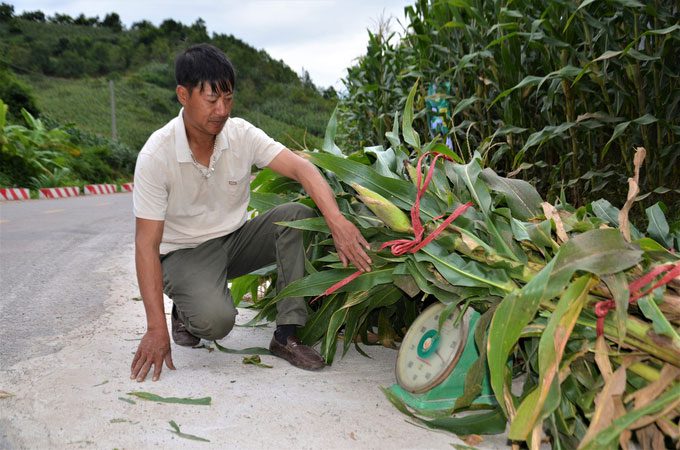
Weighing and checking the yield of the DH17-5 corn variety. (Photo: Duong Dinh Tuong).
According to Dr. Ha, despite the tense situation with Covid-19 in recent years, he has traveled extensively, establishing numerous “spark clusters” with trial models of the DH17-5 corn variety in Lao Cai, Lai Chau, Yen Bai, Tuyen Quang, Son La, Nam Dinh, Ha Nam, Thai Binh, Thanh Hoa, Nghe An… covering thousands of hectares. He believes that these small sparks will ignite a large flame, becoming a bright spot in biomass corn development. At a recent conference in Chiêng Sơn commune, Moc Chau district, Son La province, 130 delegates attended to learn about the DH17-5 variety, half of whom were directly involved in corn cultivation.
Most of them expressed surprise at the sight of entire hills filled with giant corn plants that were so tall and robust, with prominent root systems, leading some to jokingly suggest that an axe would be needed to chop them down. However, the excessive height may also be a disadvantage for the DH17-5 variety under strong wind conditions, making it susceptible to falling.
The harvested corn ears are in the waxy stage, which is the most suitable time for harvest as it ensures both yield and quality. Scientists harvested a trial area of 10m2 planted with the DH17-5 variety, weighing a total of 98 kg, indicating a yield of no less than 90 tons/ha. Given that the soil was not very good, further research is needed to explore cultivation on various soil types to find the best yields, meeting the demand for 200,000 tons of biomass corn each year for the Moc Chau dairy herd.
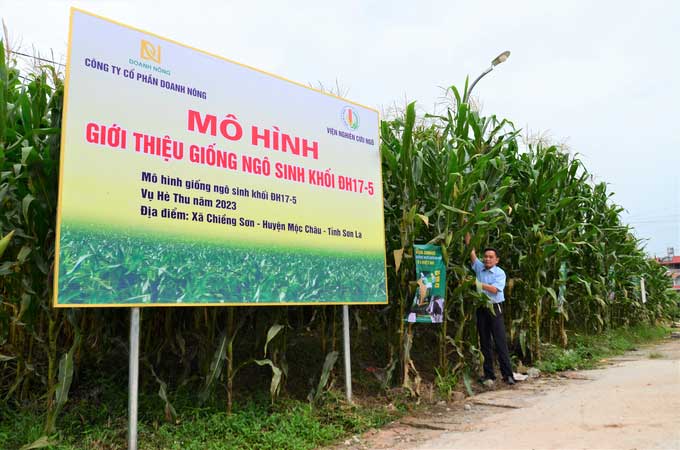
The DH17-5 corn plants are almost touching the streetlight. (Photo: Duong Dinh Tuong).
Mr. Luu Tien Hai from Quarter 4, Chiêng Sơn commune (Moc Chau district, Son La) is the owner of a 2,300m2 plot planted with the DH17-5 biomass corn variety. He noted that the price of biomass corn this year is low, only 800 VND/kg (compared to 1,200 VND/kg in previous years), but calculating costs at around 25 million VND/ha, he still nets 70 million VND/ha from planting the DH17-5 variety.
Mr. Tran Xuan Thanh – Head of the Department of Agriculture and Rural Development of Moc Chau district informed that the district has 25,000 hectares of agricultural land, including 8,000 hectares of corn. Flat land is used for rice, vegetables, flowers, and fruit trees, while poor-quality higher land is used for corn. The emergence of the first specialized biomass corn variety, DH17-5, presents an opportunity for local farmers to enhance their income. In cultivation, good varieties are essential, but achieving high yields also requires attention to care and pest control.
Ms. Cam Thi Phong – Deputy Director of the Son La Department of Agriculture and Rural Development expressed her excitement about the impressive results of the DH17-5 biomass corn demonstration model. According to her, planting biomass corn has many advantages over seed corn as it shortens the time by one month and saves labor in harvesting, shelling, and drying. Since it is biomass corn, farmers must be mindful of pesticide residue withdrawal periods during production.
| Dr. Dang Ngoc Ha and his colleagues at the Institute of Corn Research have produced over 20 different corn varieties. Anyone involved in corn farming is likely familiar with LVN10 – a hybrid corn variety that has elevated corn to the status of a “golden crop.” Now, to develop livestock farming, in addition to the demand for seed corn, there is also a need for biomass corn. Currently, the demand for biomass corn in Vietnam is about 140,000 – 150,000 hectares. |








































